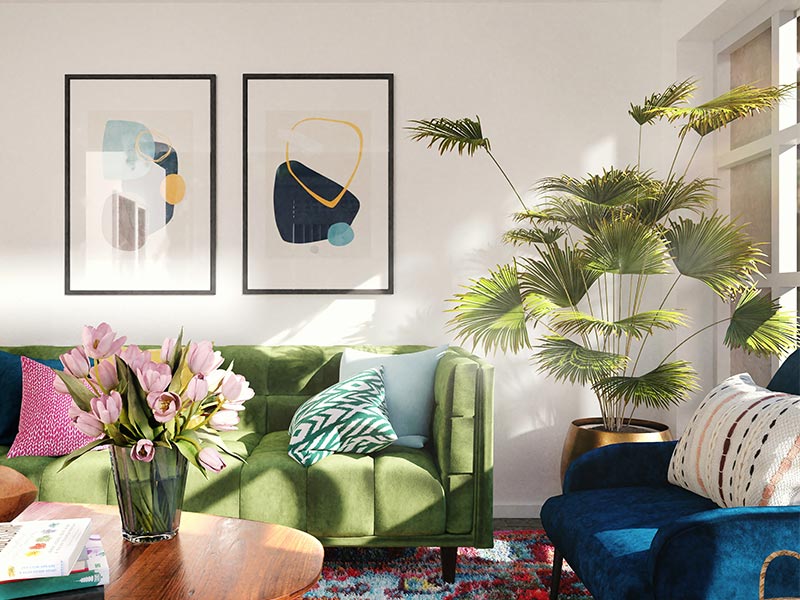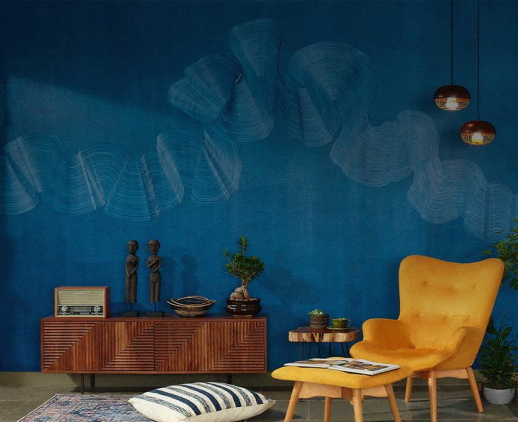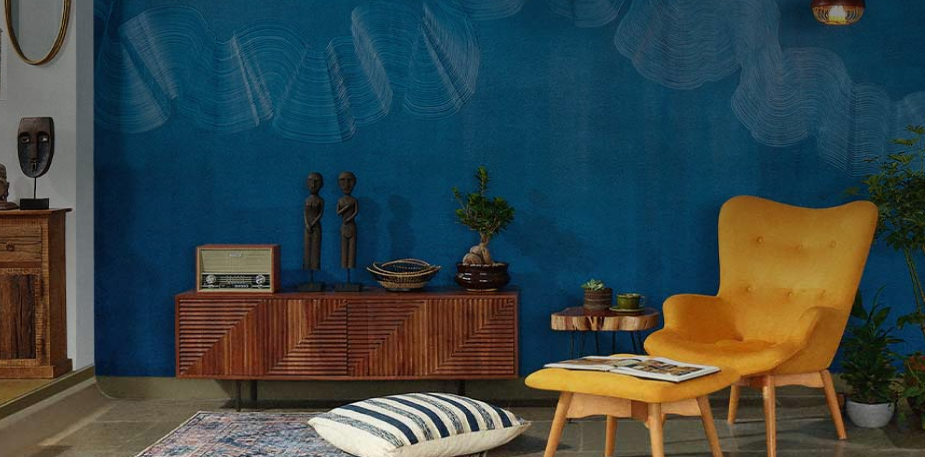Get your home interior design budget estimate
Lighting can change the way you perceive colours in your home

Lighting designer Vinayak Diwan tells us how to choose the right paint, textures, flooring for your home depending on the lighting
When I was decorating my rented apartment, I searched for the perfect shade of pale, soothing blue for my living room curtains. The room has matte grey flooring, white walls, warm lighting and is west facing. After searching in a multitude of fabric stores, I finally found a blue that made my heart sing. But when the curtains came home, they made the room look dull during the day while the pale blue just looked like light grey in the warm artificial light.
Lighting designer Vinayak Diwan, Director, Lightbook, insists both colour and lighting play an important role in interior design as well as our well-being. And that wall colour can look very different in daylight and artificial light—the direction of the daylight, as well as the colour temperature of the artificial light can also make a difference. So how do you choose, or rather avoid making a mistake when choosing your interior colours?
We tend to bring in lighting as one of the last steps in the design process but ideally, lighting, colours and materials should be thought out in conjunction. Diwan says “…when we come on board, we analyse the project volumetrically. We understand what the interior concepts are, what the architects are doing for the client, what the interior design story is…we get into the depth of the project and then the basics of lighting.” He goes on to explain that everything from the material palette, flooring, kind of ceilings to wall treatments, colour, texture and finishes has to be taken into consideration before choosing the right lighting for a space.
Read on to understand the relationship between these elements:
Natural Light and Colours
Whenever we are choosing a colour—be it paint, fabric or even something like the correct shade of makeup foundation—we tend to go out into the sunlight to get the exact shades. “Sunlight gives you the right colour rendition and saturation. Natural light enhances our interiors, so it is important to bring in as much as possible,” Diwan says. Keep in mind your city’s climate and seasons which also affects the kind of sunlight you receive—hot and bright sunlit summers, soft and dappled sunlight during winters or the dark grey skies of monsoon. It is also important to consider the direction of natural light when choosing colours for our homes.

Natural light enhances our interiors, and gives you the right colour rendition and saturation. Image courtesy, Spacejoy/ unsplash
- Rooms that are north facing receive softer light that has a slight blue tint. Colours on the dark side will appear darker while light colours are more subdued or dim. Bolder colours show up better than muted ones.
- South facing rooms receive intense light for most of the day. This light brightens dark colours while light colours, especially white, can make the room look washed out.
- East facing rooms receive morning light which adds a soft, yellow glow. As the day progresses, the light brings in a blue tint to the room. Cheerful yellows, soft blues and fresh greens look great in this light.
- West facing rooms receive warm light in the evenings making orange, red or yellow feel too saturated while the limited morning light can produce shadows and make colours look dull. Avoid colours with blue undertones in these rooms.
Understanding Artificial Lighting
Besides the natural light your homes receive, it is important to also understand artificial lighting and the role it plays in décor.

Accent lights are used to highlight interesting objects or architectural features. Image courtesy, Asian Paints
Different Types of Lighting
Diwan is a big advocate of layering lighting in your home. “Just fixing one downlight in the room is not enough,” he says. You need to combine the different types at various areas of the room and height levels to get a well-rounded space. Ambient lights illuminate the entire room, like a central hanging fixture and downlights in the ceiling. Task lights are bright lights directed towards a specific task like a table or floor lamp used in a reading corner. Accent lights are used to highlight interesting objects or architectural features, like recessed lights in cabinets or lights throwing a soft glow on artwork.
Colour Temperature of Light
Colour temperature describes the light appearance, measured in Kelvin (K) on a scale from 1,000 to 10,000.
From 2000K to 3000K, the light produced is called warm white with an orange to yellow-white appearance. Those between 3100K and 4500K are referred to as cool white or bright white and emit a more neutral white light, possibly with a slight blue tint. Above 4500K is daylight colour temperature of light, which gives off a blue-white light.
Colour Rendering Index
Colour Rendering Index (CRI) is the measurement of how colours look under an artificial light source as compared with sunlight. The index is measured from 0-100. A CRI of 100 shows the true colours of the object. Incandescent and halogen light sources have a CRI of 100. Light sources with a CRI of 90 and above are the best to showcase the actual colours you have chosen for your interiors.
The Relationship Between Colour and Lighting: How Not to Make Mistakes While Choosing
Diwan stresses the importance of colours in the interior design process—not just the ones on your walls but also the flooring, ceiling, furniture and furnishings. He goes on to give an example of certain shades of blue. “The same shade of blue looks very different in warm light, the ‘blueness’ doesn’t come out the way it should. To enhance the colour, you need to use more natural light, one with a colour temperature of 4000K, which is a bit on the whiter side. We normally do not recommend white light for areas like kids’ rooms,” he explains.
Warm tones and colours are accentuated by warm light so Diwan recommends using those warm artificial lights to bring out the cosiness of a space. “If you are using warm colours, use LEDs with a high colour rendering index so the warmth is accentuated,” he says. If you are using bright colours, Diwan suggests whiter lights (4000k and above), which enhance the appearance of these hues. He also cautions against using black on the walls. “No matter how much light you put on the ceiling, it is not going to bounce back,” he says.
Dark colours absorb more light while lighter shades reflect light. So, the lighter wall colours will reflect both natural and artificial light better making the space look bright and airy while those deep, dark shades could make the room look gloomy and drab. Diwan recommends avoiding dark colours in smaller spaces or apartments on lower floors that don’t receive enough natural light. “You can achieve a lot more with less ambient lighting if you choose lighter shades for your walls,” he says.
Texture, Material and the Role of Light
Texture is another element to consider. The play of light and shadows comes into the picture with textured paint and surfaces.

Lighter wall colours will reflect both natural and artificial light better making the space look bright and airy. Image courtesy, Asian Paints
Diwan explains, “Light coloured texture shows out better while dark coloured, heavy texture will absorb the light and will not give you the beautiful gradation of the textural element.” The choice of flooring material is also affected by light and vice versa.
“Wooden floors exude warmth and is the first layer of cosiness in a space…which should be complemented with the use of warm lighting,” he says. Stone flooring, especially those like white marble, reflect a lot more light. “The more reflective the stone, you see more light fixtures because you see the reflections on the floor,” he says. Polished stone will reflect light much more as such your ambient lighting should be carefully considered so that it does not become overwhelming.

Get Started with your interior design journey with us!
Speak to our design professionals
What’s the status of your home possession?
What’s the condition of your home/space?
Will you be living in your space during the renovation?
 Previous Question
Previous Question
Is your interior design budget over 4 lakhs?
 Previous Question
Previous Question
Book next available appointment slots with our experts!
Please Select Date and Day
 Previous Question
Previous Question

Something went wrong!
We were unable to receive your details. Please try submitting them again.

Appointment Scheduled!
Thank you for giving an opportunity to Asian Paints Beautiful Homes Service! Our Customer Experience Specialist will get in touch with you soon.
Appointment Date & time
Thank You!
Our team will contact you for further details.
What’s the status of your home possession?
What’s the condition of your home/space?
Will you be living in your space during the renovation ?
 Previous Question
Previous Question
Is your interior design budget over 4 lakhs?
 Previous Question
Previous Question
Book next available appointment slots with our experts!
DEC 2023
Please Select Date and Day
 Previous Question
Previous Question

Something went wrong!
We were unable to receive your details. Please try submitting them again.

Appointment Scheduled!
Thank you for giving an opportunity to Asian Paints Beautiful Homes Service! Our Customer Experience Specialist will get in touch with you soon.
Appointment Date & time
17 Oct 23, 03.00PM - 04.00PM





































